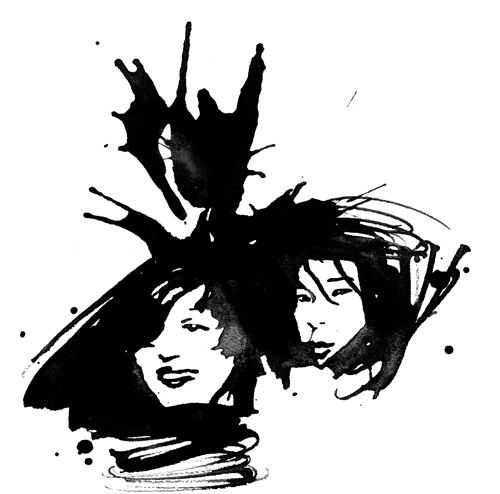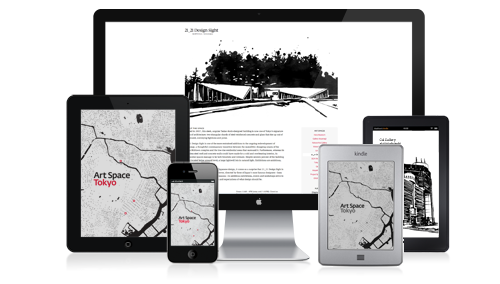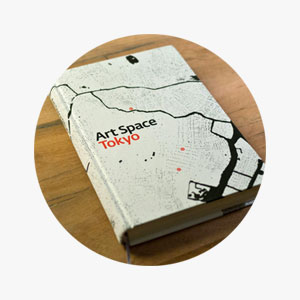Contemporary for the Community
An interview with Julia Barnes and Clint Taniguchi
Nakaochiai Gallery, Nakaochiai

JULIA BARNES, owner, co-director
Born in Wellington and moved to Tokyo in 1997. From 1999, she founded and coordinated Eyesaw, an international nonprofit arts organization based in Tokyo. In 2004, she established Nakaochiai Gallery. In February 2007, she co-founded Nonaca Co., Ltd, an experiential art firm providing project planning and production, art exhibitions and contemporary space transformations in Tokyo.
CLINT TANIGUCHI, creative director
Born in Oahu, Hawaii, and moved to Tokyo in 2004. In 2003, he co-founded Triple Base, a San Francisco art space that integrates art with community activism. Since 1995, he has provided art instruction at numerous organizations in the US and Tokyo. His artwork has been exhibited internationally, including the Yerba Buena Center for the Arts in San Francisco, the Drawing Center in New York and the Apple Store in Tokyo.
What brought you to Tokyo, Julia?
JBI came to Japan in September 1997. My birth father had lived here right after World War ii as a New Zealand peacekeeper and had visited dozens of times after that. He decided I was too young to be working in New Zealand and should see the world, so he very generously bought me an air ticket to Japan. I spent all the money in Australia midway and arrived in Japan with only 50,000 yen! At that time I was making videos in New Zealand and Australia about all kinds of community projects, such as a rock ’n’ roll high school in Melbourne. I came to Tokyo to try something a bit different.
How did you start to get involved in the Tokyo art world?
JBAt the very beginning I was making videos here. I met up with a group of artists, and together we moved around Tokyo working on a project called The Twenty-Nine Stations of the Yamanote Line, which was exhibited in 1998. Working and exhibiting with them made me realize I needed to keep meeting visual artists, and it led to me forming Eyesaw in 1999.
What kind of projects did you organize at Eyesaw?
JBWe were a not-for-profit platform for local and international upand-coming artists in Tokyo. At the beginning it was set up to be just for video makers and photographers, Japanese and foreign. We tried to remove communication barriers: the programs were all bilingual. At the start we were based in the Vision Network complex in Jingumae. After a few exhibitions we outgrew that space and moved to a couple of others, like the Nolita Apartments in Harajuku, Super Deluxe’s former space in Azabu-Juban and then to the Le Deco building in Shibuya.
How did you go from there to opening Nakaochiai Gallery?
JBWe ran Eyesaw for four years, from 1999 to 2003, at which point we went to San Francisco to hold the next Eyesaw event, and it fell through because the people who we were working with insisted that it be a completely noncommercial event, with no sponsors allowed. I found it impossible to bring a group of artists all the way from Japan to America and make something happen without any financial help, so at that point I decided to stop Eyesaw. Later, through a friend in common, I met Clint while he was in Tokyo in the summer of 2004. Several discussions later, Nakaochiai Gallery was born.
Clint, what were you doing in San Francisco before you came to Tokyo?
CTBefore I met Julia, I was running Triple Base, an art space in the Mission District, with Oliver Rosenberg. Oliver and I work collaboratively under the name Crust & Dirt, and Triple Base was our headquarters to actualize art projects and hold exhibitions for other artists. I came to Tokyo on a birthday holiday to see a different place and a different culture, and met Julia. The similarities of our backgrounds and interests inspired her to set up Nakaochiai Gallery with Triple Base as a counterpart in San Francisco and initiate an artistic dialogue between our two cities.
So your first involvement with Nakaochiai Gallery was as an artist?
CTYes. The first show at Nakaochiai Gallery was See You, which exhibited photos from a community-based project that I did with Triple Base visitors, and I had Nakaochiai visitors create their own Tokyo version. The end of the exhibition coincided with the Sankyu (Thank You) art day,1 so I participated from San Francisco via an iChat video feed and hung out with Nakaochiai visitors as they came to pick up their photographs from the project. Julia and I had been regularly using iChat to stay in touch but exploring an international artistic dialogue through technology really hit a chord, and that is how Instant Drawing Machine arose, which is a whole other story.
What made you leave San Francisco for Tokyo?
CTAfter being in San Francisco for five years, Triple Base was running well on its own, and Julia and I were wondering if she should come to San Francisco or if I should go to Tokyo. We decided to start together in Tokyo.
How do the Tokyo art world and the San Francisco art world differ?
CTThe San Francisco art community is very stimulating and has quite a legacy to show for it. Being a smaller city than Tokyo, San Francisco has a very tangible community of artists, curators and gallerists. The aesthetics are also different: the DIY spirit is alive and well there. My sense of Tokyo’s art scene is that there are many things going on but they are spread sporadically throughout the city and are less cohesive.
JBAlso the close-knit nature of San Francisco creates a sense of healthy, constructive competitiveness among the artists. They are all out there, showing at artist-run gallery spaces, commercial spaces, their friends’ spaces and so on; they’re seeing each other’s artworks constantly and helping push each other to produce better work. There is a completely different kind of pressure on artists in Tokyo: it seems to be that artists give up hope if they haven’t become successful by their mid to late twenties. To make it as an artist in the six or so years after graduation from art school is such a small window of opportunity — it’s almost impossible — whereas in San Francisco, in a sense you never grow old. It’s acceptable to be in your forties, hang out with your friends and make art, whether it’s successful or not.
CTThere are more alternative lifestyles in San Francisco, whereas here there are more limitations as to how society accepts you.
What are the main challenges you’ve faced as foreigners working in Tokyo, both at the local community level and in terms of the broader Tokyo art world?
JBI guess being accepted into the Nakaochiai community came first. I put in a lot of effort to make sure that the whole neighborhood was informed about what we were doing a couple of weeks prior to the exhibitions, to smooth things over. We eventually managed to integrate into the community, but it did take a while.
CTWe are interested in exhibiting international artists who engage both mainstream art audiences and the layman or the local community. For example, for her exhibition in 2007, Amanda Browder2 made a call for donations for soft materials and clothes that she could incorporate into her installation. That show was really well received by the people living in this neighborhood. We had old and young folks coming to the exhibition opening for the first time, curious to see what had happened to their old futons and clothes.
JBIn terms of the Tokyo scale, to be honest, we really haven’t felt the need for Nakaochiai Gallery to become a part of the broader art world. We just wanted to be here, concentrating on the community in this neighborhood where we live. We do go out and see what’s out there, of course, and when we meet people who are interested in what we are doing, we bring them to the gallery. For us to engage a local community, which has had little or no exposure to contemporary art, is full of challenges!
CTWe really appreciate the people who go out of their way to come and support us and we have managed to cultivate a very healthy community of people around our gallery, made up of both Japanese and foreigners—it’s a mutually stimulating environment.
Have their been any particular advantages in being foreigners working in the Tokyo art world?
CTWhile the foreign audience in Tokyo may be a minority, that audience tends to be very excited and interested in what we’re doing. Some foreign residents have told us that they don’t feel too comfortable in Japanese galleries, that they’re not being helped, that the Japanese contemporary art world feels very inaccessible to them and yet they’re looking to find work by Japanese artists. So we’re able to accommodate those needs.
What do you look for in the work of the Japanese artists you represent?
JBWe choose them for their aesthetics, their use of materials and their sense of narrative. All of the Japanese artists we work with are people I have known for many years, and during that time I’ve been watching very closely to see how they have developed their work. I can see how seriously they take their practice and I know that they will be making their work until the day they die; their art is innate to them.
What kind of international artists do you represent? Who are they, how do you meet them and how do you judge whether or not they will connect with the Tokyo audience?
JBThe artists that we choose tend to be not only people who create visual artwork, but also people whose investigations challenge us, engage communities and explore the experiential side of art. We meet artists through research, artists’ friends and through the Net, and we make most of our decisions with our gut instinct.
How has your experience of curating at Nakaochiai Gallery differed from what you were doing back in San Francisco?
CTI think just the sensibility and the awareness is very different. In Tokyo, there’s not as much assumed knowledge about what art is or what is going on in the scene here or abroad. The people we show are from a variety of different cultural backgrounds, so to a degree, part of what they are saying may be lost in translation; we have to think about how things are presented to the audience here or else some messages may not be understood. It might benefit the artists to show here, but if they are not connecting with the Japanese, then there is no real meaning to it.
What made you set up Nonaca and start holding exhibitions in people’s apartments?
CThe name Nonaca comes from “no naka” which means “inside” in Japanese. We are interested in contemporary art projects that transform the inside of spaces, be it the physical space of a room or the inner space within ourselves.
JBThe idea was born out of practical considerations. We wanted to show Akira’s works, some of which are painted on very large boards, but we couldn’t fit any more than two into the gallery. When we were at one of our clients’ homes, we noticed how big the walls were, and when we suggested to them the idea of holding an exhibition in their apartment, they were very positive about it.
Even before that we had begun to find it too time-consuming to have our clients, many of whom live on the other side of the city, come and visit the gallery. We love being based in this residential neighborhood, but we also see the value of working in other spaces that are central and easily accessible to people. I think working in different spaces also introduces diversity into our program, for the viewer, for the artist and for us. In contrast to our locally grounded work with Nakaochiai Gallery, Nonaca’s mission is to engage a much wider audience in Tokyo.
What are the curatorial challenges of working in a domestic space as opposed to a gallery space?
CTLighting, how much you are able to transform the space and working to make it a positive experience for the clients. Usually it’s their first time to have their home rearranged for an exhibition, which is then presented as a semi-public event that brings strangers in. But I think that all of these apartment events have been positive experiences. I like how it fits in with the inherent transience of Tokyo’s composition; this city changes itself all the time.
How has Tokyo’s art scene changed in the ten years that you’ve been here?
JBThe biggest change I’ve seen has been the increase in accessibility for younger artists. An increase in artist-run galleries and art cafés provides a better platform for people who are starting to show their work and get noticed, and it bridges the gap between making the work and showing it in a gallery. That’s the gap that I was trying to bridge with Eyesaw, back in the time when these places didn’t really exist.
There are now even these little shoebox galleries in places like Koenji, which artists can rent out to display their work; they’re mostly craft-oriented, but we’ve discovered some interesting people through them. Big events like GEISAI and Design Festa have also helped to promote young artists, and of course several new museums have opened. New bilingual publications like ART iT came out and in terms of making information about the art world truly bilingual and accessible, Tokyo Art Beat pulled the entire scene together. I think that contemporary art is more well known within Japan nowadays; it’s talked about more in the mainstream media and in general there’s more hype about it than there was five or ten years ago.
Noted
- Taking place on March 9 every year, this event was set up by artist Yoshiaki Kaihatsu to encourage galleries and museums to make art more accessible to people, whether it be through discounted entry fees, guided gallery tours or workshops. The name is a play on the date: 3/9 is read “san-kyu” in Japanese, sounding similar to the words “Thank You.” See details at http://39art.com.↩
- Amanda Browder — Beautiful Flux was held from March 4 to March 24, 2007.↩
Update
After six years of exhibitions, Nakaochiai Gallery closed on November 27, 2010. Julia Barnes and Clint Taniguchi decided to move their home to Mejiro and continue their art activities without a permanent gallery space. In mid-2011 they relocated to New Zealand.

